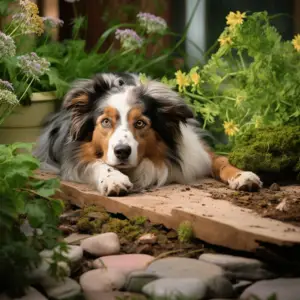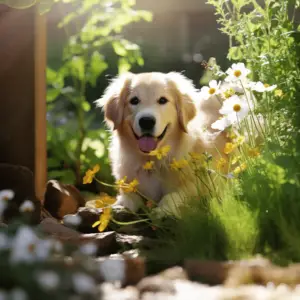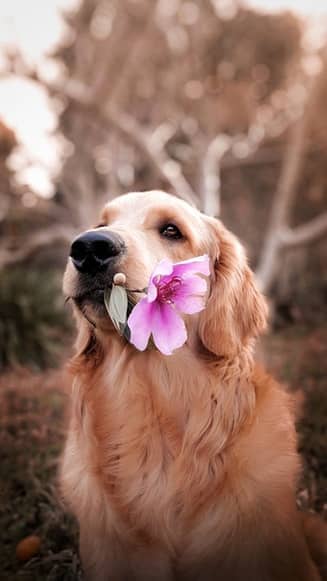Dog Urine Damage, are said to be man’s best buddies throughout history. Unfortunately, the best friend of a man isn’t always the best friend of plants.
Dogs may trample plants and damage stems, they may dig up plants, and they may decide that your prized peony is the best site for a potty break. It can feel like a never-ending effort to keep dogs out of your garden.
We’ll go through some of the methods you can use to protect your plants from dog urine in this article. But first, let’s take a look at why dog urine is bad for your plants.
Why is Dog Urine Bad for Your Plants?

Dog urine can produce brown/yellow stains on plants and the death of some plants. We’ll talk about the mechanism that leads to that in this section of the article.
You may wonder why this is significant. You must first determine which chemicals in your furry pet’s urine are causing damage to your plants to address the problem effectively.
Urea
First and foremost, realize that your paw-some pal is utterly unaware that its pee is doing havoc on your plants. It’s not like your dog is attempting to destroy your rose bushes on purpose.
Urea, on the other hand, is the principal green killing component in your dog’s pee. Simply put, urea is a substance that is produced when protein is consumed. As a result, urea can also be found in human urine. The issue is that dogs require a high-protein diet to remain healthy. The more protein they eat, the more poisonous their pee is to your plants.
Nitrogen
Did you know that urea contains nitrogen, which is used to nourish plants? However, there is such a thing as too much of a good thing can be poisonous. In the same way, too much nitrogen can be harmful to your plants. When it comes to dead plants, the volume of your dog’s urine, in addition to the urea, is a fact.
PH Level
Another issue is that your dog’s urine might influence the pH of the plants’ soil, causing it to become too alkaline. This, in turn, can harm the plant’s roots and contribute to its death.
How to save plants from dog urine
Having looked at why dog urine is harmful to your plants and the mechanisms through which these harmful effects occur, let’s now dive in deeper and find out how you can protect your plants from dog urine.
Make a Pee Area for Your Dog
Designating a no-go zone is one of the most effective strategies to eliminate dog urine plant spots. For example, if your pet does business in one area of the yard, the rest of your garden will be safe from the chemicals in his pee.
By covering a specific part of your yard with sand, gravel, and soil, you can easily create a pee spot for your dog. You can also plant urine-resistant grass and plants near the spot to prevent harm from near-misses.
Rosemary, peppermint, carpet bugle, and other herbs and shrubs are all listed in the list of plants that are resistant to dog urine.
Make sure, however, that any plants you utilize near the pee zone are safe for your dogs. Dogs are known to be poisoned by plants such as asparagus fern, aloe vera, and daffodils. Finally, to avoid an excess of nitrogen build-up, avoid using nitrogen-rich fertilizers in the specified pee-zone.
Fencing
Fencing off your garden is another fantastic approach to protect your plants from dog urine. Consider this a step to be superior to the dedicated pee-zone concept.
When a dog needs to relieve itself, it must do so. That is why, when your dog misbehaves, fencing your yard will provide the necessary safety for your beautiful turf.
Fencing is also an excellent way to protect your garden from extra fixes, such as dog urine plant treatment or gypsum urine neutralizing salts. As a bonus, you might want to consider getting a dog fence window to let your dog see other parts of your garden without destroying your plants.
Dilute the Dog Pee by Watering
If possible, irrigate the peed-on area right away to dilute the urine and reduce plant damage. It is also a good idea to ensure that your dog has constant access to water for similar reasons. Your plants will be less harmed by pee that has been diluted. After all, who likes a dehydrated dog?
Urine Burn Application
Various elements are available for purchase to break down ammonia even more successfully than water.
So, if you have a few plants around your house and your dog is constantly urinating on them, you might want to carry a squirt bottle of pee-weakener with you on walks to minimize the damage.
If your local store doesn’t have it, you can get it as a tablet online and mix it up as needed.
Feed a Good Diet to Your Dog

Changing a dog’s food, according to some experts, can help reduce the amount of urea in their pee. It’s likely that your dog is unable to digest the protein it’s currently consuming. Changing your dog’s protein from fish to beef or beef to chicken is worthwhile.
Certain specialists also recommend supplements that bind nitrogen or aid digestion. However, before you consider giving your dog supplements, consult with your veterinarian first. A veterinarian can advise you on whether or not such a supplement is necessary.
Other Frequently Asked Questions
Does Lime Neutralize Dog Pee on Grass?
If the pH factor of your dog’s pee is the cause of the grass burn, adding dolomite lime may help. Magnesium and calcium carbonates are used to make dolomitic lime.
However, you should be aware that lime will only help if the pH of the soil has become more acidic as a result of your dog’s urine. If your soil has much alkali, spraying lime on grassy areas won’t assist much.
What Plants Can Withstand Dog Urine?
Some plants are resistant to dog urine, believe it or not. What’s more, such plants are relatively easy to come by. Wintercreeper, Kinnikinnick, Basil, and Oregano are a few examples.


